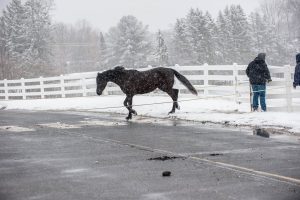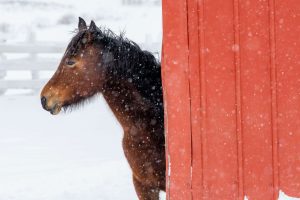Enjoying the Winter with Your Horse
Author: Jenifer Nadeau
jenifer.nadeau@uconn.edu
Reviewer: Debra Hagstrom, Illinois Extension
Publication: EXT082 | March 25, 2022
One of the benefits of living in places that experience true winter is the ability to enjoy the changing seasons. By being properly prepared, there is no reason not to enjoy winter horseback riding. Here are a few tips for being prepared, using the letters from the the song Let It Snow for inspiration.
L – Winter is a great time for learning something new. Attending an adult education class, reading a new book on training techniques or horse care, checking out webcasts or courses at My Horse University (www.myhorseuniversity.com), or reading articles and learning lessons at eXtension.org/horses (https://horses.extension.org/), will ensure finding some new information or reviewing previous concepts.
E – Winter is a good time to examine the horse’s ENVIRONMENT and what might changed or improved. Whether the paddock is a muddy mess, or upgrades to the your facility are desired, studying the problem areas will allow for the development of a plan. Here are some ideas of what to do.
T – Winter is a good time to keep up on or get involved in TRAINING. There is that new trainer you heard about, or that clinic you have been wanting to attend, and don’t forget the CT Horse Symposium!
I – Finding ways to deal with ICE is important. Some simple things to do include obtaining some footwear traction devices for walking on ice, such as Yaktrax, stabilizers, or micro spikes (UConn Extension does not promote any of these specific products). Also have some ice melt; look at the labels to ensure pet-safe products. Kitty litter or sand can also be used to spread where in walkways and paths.
T – This is a great time to check TACK, to be sure that everything is safe and comfortable for the horse. Look at the halter – is it fraying, ripped, buckles torn out? Is it time for a replacement? Examine the bridle – is there a throatlatch? Are screws intact? Are buckles working? Are holes ripped out or tearing? Is the leather tearing or wearing? Check thesaddle – is the tree in good shape? On the English saddle, is the safety latch on the stirrups down and open so that the stirrup will slide off if the rider gets hung up so that they will not be dragged? Is the padding in the panels of your saddle even? Are there any sharp points on the underside of your saddle? Are your leather holes stretching or tearing? How is the stitching? What condition are harnesses in? Does anything need cleaning? Are the pads clean and free of burrs, etc? Are there other equipment or tack items needed?
S – SHOES can make all the difference. When hitting the trails this winter, consider getting snowball pads and perhaps adding borium or frost-ribbed nails. Speak to the farrier about which traction device will work best.
N - NUTRITION is also something that is good to get a handle on in the winter. Often, horse owners mistakenly increase grain in the winter to provide horses with more energy, even though the horse may be doing less work. Instead, it is best to provide more forage, since the heat of hay fermentation in the gut helps horses stay warmer in colder temperatures. More hay also more closely mimics the horse’s evolutionary diet. This is also a great time to practice body condition scoring. There is a great module available for learning how to do this online at https://horses.extension.org/. Body condition scoring the horse monthly will help understand when it is time to change either the horse’s diet, increase exercise, or both.
O – Now is the time to ORGANIZE. Organize things needed, by season, into a trunk or plastic container, cleaning anything that is dirty. It’s also a good time to reorganize the tack room, making sure there are enough hooks, saddle stands, or places to hang that harness or training gear. Seasonal downtime is also a good time to strategize for the upcoming show season, trail outings, and other events. Make a list of what is needed every time the horse is trailered to refer to it each time. It can really save a lot of time and, even if additions are made regularly. Also, this is a good time to get the horse’s papers in order. Have a file folder for registration papers, veterinary related papers, papers needed for travel such as Coggins, association memberships, etc. and keep them alphabetized and in order, and kept in a place to easily access them when needed.
W – WATER can be a real problem in the wintertime. Making sure that horses drink enough water will keep them healthy, hydrated, and help prevent impaction colic. Reduced water intake results in reduced feed consumption by horses. Studies have shown that horses prefer water that is not too cold. A 2003 study by the University of Pennsylvania found that horses drank 41% more water when it was heated rather than when it was allowed to stay at near freezing temperatures. During winter months, increase the temperature of water to 45 to 65 degrees F to maximize consumption. Also, be sure to eliminate sources of icy water; when present, horses tend to drink icy water exclusively, but in less volume compared to when only heated water is on hand.
Check out other online resources at https://animalscience.cahnr.uconn.edu/equine-extension-program/
Additional Resources
Kristula, M.A.; McDonnell, S.M. (1994). Drinking water temperature affects consumption of water during cold weather in ponies. Applied Animal Behaviour Science, 41: 155-160.
McDonnell, S.M.; Kristula, M.A. (1996). No effect of drinking water temperature on consumption of water during hot summer weather in ponies. Applied Animal Behaviour Science, 49: 149-163.
Suggested Reading
CT Horse Environmental Awareness Program - https://ctrcd.org/wp-content/uploads/2017/10/
Emergency Preparedness Help - https://aaep.org/horse-owners/owner-guidelines/owner-emergency-disaster-and-preparedness
Horse Facility Articles - https://horses.extension.org/category/facilities/
Horse Nutrition Articles - https://horses.extension.org/category/nutrition/
My Horse University - www.myhorseuniversity.com
UConn Equine Extension Information - https://animalscience.cahnr.uconn.edu/equine-extension-program/
The information in this document is for educational purposes only. The recommendations contained are based on the best available knowledge at the time of publication. Any reference to commercial products, trade or brand names is for information only, and no endorsement or approval is intended. UConn Extension does not guarantee or warrant the standard of any product referenced or imply approval of the product to the exclusion of others which also may be available. The University of Connecticut, UConn Extension, College of Agriculture, Health and Natural Resources is an equal opportunity program provider and employer

